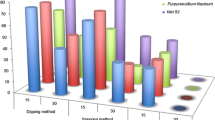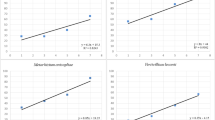Abstract
The tomato leafminer, Tuta absoluta (Meyrick) (Lepidoptera: Gelechiidae) is an important pest of tomato crops in South America and it has recently arrived in Europe affecting tomato plantations. The susceptibility of T. absoluta larvae and pupae to three species of entomopathogenic nematodes (Steinernema carpocapsae, Steinernema feltiae and Heterorhabditis bacteriophora) was examined under laboratory conditions. Leaf bioassays were conducted to evaluate the nematode’s capability to reach the larvae and kill them within the galleries. The efficacy of the three nematode species after foliar application to potted tomato plants was evaluated under greenhouse conditions. High larval mortality (78.6–100%) and low pupae mortality (<10%) was determined in laboratory experiments. In the leaf bioassay a high level of larval parasitation (77.1–91.7%) was recorded revealing the nematode’s capacity to kill the larvae inside the galleries. In the pot experiments nematode treatment reduced insect infection of tomato plants by 87–95%. The results demonstrate the suitability of entomopathogenic nematodes for controlling T. absoluta.





Similar content being viewed by others
References
Abbott WS (1925) A method of computing effectiveness of an insecticide. J Econ Entomol 18:265–267
Ameixa O, Almeida L, Gonçalves A, Neto L (2007) Feeding behaviour of Liriomyza huidobrensis (Blanchard) and L. trifolii (Burgess) adults on bean leaves. J Insect Behav 20:137–154
Apablaza J (1988) Avances en el control de la polilla del tomate. Evaluación del insecticida cartap Rev Cien Tec 35:27–30
Arthurs S, Heinz KM, Prasifka JR (2004) An analysis of using entomopathogenic nematodes against aboveground pest. Bull Entomol Res 94:297–306
Begley JW (1990) Efficacy against insects in habitats others than soil. In: Gaugler R, Kaya HK (eds) Entomopathogenic nematodes in biological control. CRC Press, Boca Raton, pp 215–231
Boemare N (2002) Biology, taxonomy, and systematics of Photorhabdus and Xenorhabdus. In: Gaugler R (ed) Entomopathogenic nematology. CABI International, Wallingford, UK, pp 35–56
Castelo-Branco M (1992) Flutuaçao populacional da traça-do-tomateiro no Distrito Federal. Hortic Bras 10:33–34
Collavino MD, Gimenez RA (2008) Efecto del imidacloprid en el control de la polilla del tomate Tuta absoluta (MEYRICK). Idesia 26:65–72
EPPO (2005) Data sheets on quarantine pests, Tuta absoluta. European and Mediterranean Plant Protection Organization. Bull OEPP/EPPO 35:434–435
EPPO (2009) Pests and diseases. In European and Mediterranean Plant Protection Organisation Reporting Service. http://archives.eppo.org/EPPOReporting/2009/Rse-0908.pdf. Accessed 1 Aug 2009
Estay P, Bruna A (2002) Insectos, ácaros y enfermedades asociadas al tomate en Chile. Colección Libros INIA, Santiago de Chile, p 111
Glazer I, Klein M, Navon A, Nakache Y (1992) Comparison of efficacy of entomopathogenic nematodes combined with antidesiccant applied by canopy sprays against three cotton pests (Lepidoptera: Noctuidae). J Econ Entomol 85:1636–1641
Gonçalves-Gervasio R de CR, Vendamim JD (2007) Bioactivity of aqueous neem seeds extract on the Tuta absoluta (Meyrick, 1917) (Lepidoptera: Gelechiidae) in three ways of application. Ciência e Agrotec 31:28–34. doi:10.1590/S1413-70542007000100004
Grewal PS, Ehlers R-U, Shapiro-Ilan DI (eds) (2005) Nematodes as biocontrol agents. CABI Publishing, Oxon, UK, p 528
Haji FNP, Olivera CA, Amorim Neto MS, Batista JGS (1988) Fluctuaçao populational da traça do tomateiro no ub médio Sao Francisco. Pesqui Agropecu Bras 23:7–17
Head J, Lawrence AJ, Walters KFA (2004) Efficacy of entomopathogenic nematode, Steinernema feltiae, against Bemisia tabaci in relation to plant species. J Appl Entomol 128:543–547
Henneberry TJ, Forlow JL, Burke RA (1995) Pink bollworm (Lepidoptera: Gelechiidae), cabbage looper, and beet armyworm (Lepidoptera: Noctuidae) pupal susceptibility to steinernematid nematodes (Rhabditida: Steinermatidae). J Econ Entomol 88:835–839
Henneberry TJ, Forlow JL, Burke RA (1996) Pink bollworm adult and larvae susceptibility to steinernematid nematodes and nematode persistence in the soil laboratory and field test in Arizona. Entomologist 21:357–368
Kaya HK, Stock SP (1997) Techniques in insect nematology. In: Lacey LA (ed) Manual of techniques in insect pathology. Academic Press, San Diego, pp 281–324
Kim HH, Jeon HJ, Cho CY, Lee DW, Choo HY (2006) Persistence of entomopathogenic nematode, Steinernema carpocapsae GSN1 strain on vegetable leaf in greenhouses. Korean J Sci Technol 24:198–204
Klein MG (1990) Efficacy against soil-inhabiting insects pest. In: Gaugler R, Kaya HK (eds) Entomopathogenic nematodes biological control. CRC Press, Boca Raton, pp 195–214
Lietti MMM, Botto E, Alzogaray RA (2005) Insecticide resistance in argentine populations of Tuta absoluta (Meyrick) (Lepidoptera: Gelechiidae). Neotrop Entomol 34:113–119
Lindegren JE, Meyer KF, Henneberry TJ, Vail PV, Forlow Jech LJ, Valero KA (1993) Susceptibility of pink bollworm (Lepidoptera: Gelechiidae) soil associated stages to the entomopathogenic nematode Steinernema carpocapsae (Rhabditida: Steinernematidae). Southwest Entomol 18:113–120
Lopes-Filho F (1990) Tomate industrial no submédio Sao Fracisco e aspragas que limitamsua produçao. Pesqui Agropecu Bras 25:183–288
Marchiori CH, Silva CG, Lobo AP (2004) Parasitoids of Tuta absoluta (Meyrick 1917) (Lepidoptera: Gelechiidae) collected on tomato plants in larvas, state of Minas Gerais, Brazil. Braz J Biol 64:552–554
Medeiros MA, De Vilela NJ, Franca FH (2006) Eficiência técnica e econômica do controle biológico da traça-do-tomateiro em ambiente protegido. Hortic Bras 24:180–184
Miranda MMM, Picanco M, Zanuncio JC, Guedes RNC (1998) Ecological life table of Tuta absoluta (Meyrick) (Lepidoptera: Gelechiidae). Biocontrol Sci Technol 8:597–606
Moraes GJ, Normanha Filho JA (1982) Surto de Scrobipalula absoluta (Meyrick) em tomateiro no trópico semi-árido. Pesqui Agropecu Bras 17:503–504
Nbata GN, Shapiro-Ilan D (2005) Laboratory evaluation of virulence of heterorhabditid nematodes to Plodia interpunctella Hübner (Lepidoptera: Pyralidae). Environ Entomol 34:676–682
Niedmann Lolas L, Meza-Basso L (2006) Evaluación de cepas nativas de Bacillus thuringiensis como una alternativa de manejo integrado de la polilla del tomate (Tuta absoluta (Meyrick); Lepidoptera: Gelechiidae) en Chile. Agric Tec 66:235–246
Ortega F, Astor E, Scals D (2008) El control de la polilla del tomate (Tuta absoluta). Hortic Int 64:30–31
Poinar JR, GO (1990) Biology and taxonomy of Steinernematidae and Heterorhabditidae. In: Gaugler R, Kaya HK (eds) Entomopathogenic nematodes in biological control. CRC Press, Boca Raton Fla, pp 23–62
Prabhuraj A, Viraktamath CA, Kumar ARV, Tandon PL, Ballal CR, Jalali CR, Rabindra RJ (2003) Pathogenicity of two entomopathogenic nematodes against Holotrichia serrata (Fabricius) (Coleoptera: Scarabaeidae) and Spodoptera litura (Fabricius) (Lepidoptera: Noctuidae). In: Biological control of lepidopteran pests. Proceedings of the symposium of biological control of Lepidopteran pests, pp 205–209
Riquelme VM, Botto EN, Lafalce C (2006) Efficacy of insecticides against the “tomato moth”, Tuta absoluta (Lepidoptera: Gelechiidae) and their residual effects on the parasitoid Trichogrammatoidea bactrae (Hymenoptera: Trichogrammatidae). Rev Soc Entomol Argent 65:57–65
Rodriguez SM, Gerding P, France A (2005) Selección de aislamientos de hongos entomopatógenos para el control de huevos de la polilla del tomate, Tuta absoluta (Meyrick) (Lepidoptera: gelechiidae). Agric Tec 66:151–158
Schroer S, Ehlers R-U (2005) Foliar application of entomopathogenic nematode Steinernema carpocapsae for biological control of diamondback moth larvae (Plutella xylostella). Biol Control 33:81–86
Siqueira HAA, Guedes RNC, Fragoso DB, Magalhaes LC (2001) Abamectin resistance and synergism in Brazilian populations of Tuta absoluta (Meyrick) (Lepidoptera: Gelechiidae). Int J Pest 47:247–251
SSV, Servei de Sanitat Vegetal (2008) Actuaciones en cultivos hortícolas. Aplicación de las medidas fitosanitarias para la prevención y el control de Tuta absoluta. Informe técnico, Barcelona, p 115
Tomalak M, Piggott S, Jagdale GB (2005) Glasshouse applications. In: Grewal PS, Ehlers R-U, Shapiro-Ilan DI (eds) Nematodes as biocontrol agents. CABI Publishing, Oxon, pp 147–166
Torres JB, Faria CA, Evangelista WS Jr, Pratissoli D (2001) Within-plant distribution of the leaf miner Tuta absoluta (Meyrick) immatures in processing tomatoes, with notes on plant phenology. Int J Pest Manag 47:173–178
Urbaneja A, Vercher R, Navarro V, Porcuna JL, García Marí F (2007) La polilla del tomate, Tuta absoluta. Phytoma España 194:16–23
Williams EC, Walters KFA (1999) Foliar application of entomopathogenic nematode Steinernema feltiae against leafminers on vegetables. Biocontrol Sci Technol 10:61–70
Woodring JL, Kaya HK (1998) Steinernematid and heterorhabditid nematodes: a handbook of techniques. South Cooper Bull 331:1–30
Acknowledgments
Many thanks to IRTA-Cabrils for rearing T. absoluta pupae and larvae, to Servei de Sanitat Vegetal (Generalitat de Catalonia) for all their effort and help, Miquel Coll to allow us to use his orchard and Jack Skuse for language revision of the manuscript. This research was supported by a Project of the Spanish Instituto Nacional de Investigacion y Tecnologia Agraria y Alimentaria (INIA).
Author information
Authors and Affiliations
Corresponding author
Additional information
Handling Editor: Ralf Ehlers
Rights and permissions
About this article
Cite this article
Batalla-Carrera, L., Morton, A. & García-del-Pino, F. Efficacy of entomopathogenic nematodes against the tomato leafminer Tuta absoluta in laboratory and greenhouse conditions. BioControl 55, 523–530 (2010). https://doi.org/10.1007/s10526-010-9284-z
Received:
Accepted:
Published:
Issue Date:
DOI: https://doi.org/10.1007/s10526-010-9284-z




